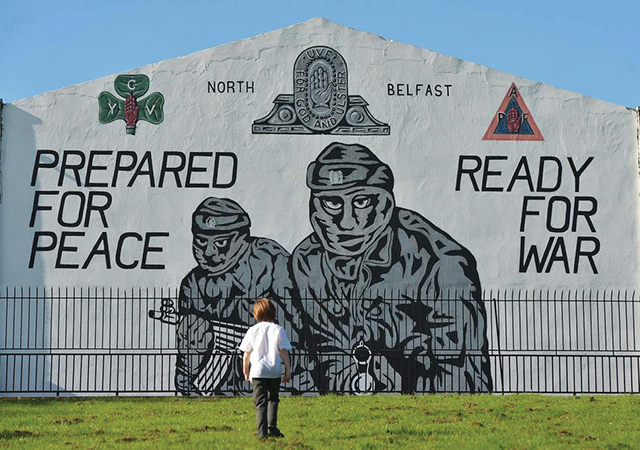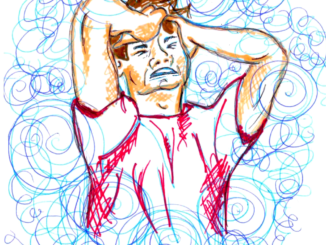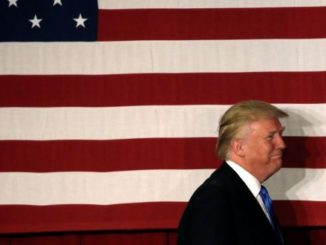
The signing of the Good Friday Agreement twenty-four years ago this month brought to an end the inter-ethnic violence that wreaked havoc in Northern Ireland since its inception in 1921. The accord’s wide-reaching ambitions included the emergence of the ‘Northern Irish’ identity. However, it also gave its citizens the legal right to become Irish nationals and thus Republic of Ireland footballers, reigniting the rivalry between the island’s two footballing associations.
Apart from dissent from the extreme of both ends of the political spectrum, both nationalists and unionists welcomed the Good Friday Agreement. Each party presented the accord as a tribal victory over the other. For unionists, it firmly entrenched Northern Ireland’s place within the union; for nationalists, it was another forward leap towards Irish reunification, displaying the zero-sum politics that still endure in the north today.
It is a truism that, across the globe, soccer has always been a working-class pastime, and it is no different across the six counties. In the north, soccer is a significant factor in the social identity of many, with the working-class fan base a hotbed of activity for cultural identity. The stipulations of the Good Friday Agreement allowed players the freedom to choose their national allegiance and fans to have a greater connection to one side or the other. The quest for a shared Northern Irish identity has, initially at least, given those from both communities separate cultural identifiers, in which national team they support or declare for. In contrast, the aim was for those communities to reconcile through their shared lives in Northern Ireland.
Through Article 1(iv) of the Good Friday Agreement, which recognised ‘the birthright of all people of Northern Ireland to identify themselves and be accepted as British, or Irish, or both,’ it allowed unionists in Northern Ireland to consider themselves Northern Irish, without compromising their British identity and allowed nationalists in the north to embrace their Irishness without the connotations of supporting violence.
Although this unique constitutional arrangement brought peace, it brought an unusual but predictable dispute in eligibility for FIFA competitions. When the Good Friday Agreement is viewed alongside FIFA’s eligibility rules in its statutes book, there are contradictory interpretations of nationality and eligibility. Specifically, Article 17 and 18 of FIFA’s statutes, deals with eligibility and a player’s acquisition of another nationality. Article 18 allows players that hold more than one nationality or acquire a new nationality the chance to choose which association they represent, whilst Article 17 deals with the terms of that acquisition. In Article 17 terms, a player must be ‘born on the territory of the relevant association’; however, the Good Friday Agreement, as a legally binding agreement, ultimately supersedes these terms and renders them obsolete. This essentially created a loophole that allowed the FAI to expand its talent pool, which the IFA or FIFA could prevent.
The high profile defections by players from North of the border to the Republic of Ireland ultimately reignited the century-old rivalry between the two associations. Creggan-born Darron Gibson departed despite desperate efforts from IFA, with his decision seen as the catalyst for further defections, such as fellow Derry men Shane Duffy and James McLean as well as Marc Wilson. Through these defections, the IFA and FAI have inadvertently become a means for expressing identity for the two communities in Northern Ireland.
Prior to the Good Friday Agreement, nationalist players in Northern Ireland did not choose who they represented, despite their emotional and cultural bond to the Republic growing up. Players such as Martin O’ Neill, Gerry Armstrong, Pat Jennings and Neil Lennon represented Northern Ireland with distinction and success. However, it was a situation involving Lennon that became a turning point in the Nationalist/Catholic relationship with Northern Ireland. The death threats and other nefarious objects that Lennon received did little to encourage other players of similar backgrounds to the then captain.
The Lennon situation further entrenched Nationalists’ view of the IFA and the Northern Ireland team as a vehicle of sectarianism and division. It demonstrated the belief that Northern Irishness was an extension of Britishness. This is corroborated by the Northern Irish teams’ use of British identifiers and emblems such as ‘God Save the Queen’ and supporters’ former use of the Union Jack flag.
Stewart Cherry, a history major at Queen’s University Belfast and Protestant from Kilkeel, Co. Down who subsequently played Gaelic football for St. Peter’s of Manchester, believes ‘God Save The Queen’ is an unnecessary stumbling block for the national team.
He said, “We should not be singing ‘God Save The Queen’. We shouldn’t be doing it. I don’t sing it. In football terms, we are a British team, the same way we’re a European team. I can’t fucking stand England, Scotland or Wales. Can’t stand them.”
Cherry continued, “We’re a Northern Irish team; that’s what we are. We’re representing Northern Ireland. So we shouldn’t be singing ‘God Save The Queen.’”
The unique situation of post-Good Friday Agreement IFA is that their previous (and current) identifiers are antagonistic to one of the diametrically opposing communities that they hope to represent. Those connected to their Irish identity see the use of God Save the Queen or the Ulster Banner as exclusionary, whilst those who are closely linked to their Britishness see the removal of these symbols as a further diminution of their culture.
Twenty-three years on, Stormont nor the IFA has made any compromises on flags or anthems, meaning Northern Ireland faces an identity crisis in the absence of an explicit shared cultural identifier such as anthems, flags, passports or other paraphernalia of national belonging. The ambivalence to change further perpetuates the Nationalist narrative that the Northern Ireland team is an exclusively Unionist sphere.
Cherry believes politicians and officials have the ability to introduce immediate change to unnecessary obstructions such as the anthem and flag. He said, “The IFA can change tomorrow. They could make ‘Danny Boy’ tomorrow; the Commonwealth games team have it. The IFA could do that tomorrow. And they should do, 100%.”
Nationalists often saw Windsor Park as a bastion of Unionism. Sectarian and anti-IRA songs such as ‘The Billy Boys’ and ‘The Sash My Father Wore’ frequently echoed throughout the stands, compounded by other iconography associated with overt Britishness. The IFA have made vigorous attempts to transform the national stadium into a politically neutral stadium, at least during international games, as the stadium is also the home of Linfield.
The IFA’s ‘Football for All’ campaign can be seen as a legitimate attempt to move Northern Ireland games away from the sectarian atmosphere surrounding the game day. Despite losing two of its members for its support of the ‘Football for All’ campaign, the Amalgamation of Northern Ireland Supporters Clubs (AONISC) played a crucial role in the attempts to dispel sectarianism from games. The AONISC acted as a self-policing system at games where they strategically placed their members throughout Windsor Park to essentially drown out potential bigotry. This included drums and loudspeakers that replaced sectarian songs with socially acceptable tunes such as ‘Sweet Caroline’, as well as the reduction of red, white and blue paraphernalia for green, the actual colour of the teams’ jersey. Although the change in atmosphere has not changed the mind of Nationalist supporters, it has allowed a middle ground for Unionists who were forced away by the extreme politicisation of games to return.
Former Northern Ireland manager Michael O’Neill, himself a Catholic, was instrumental in improving the national team’s fortunes, leading them to the European Championship in 2016. He also played a crucial role in cultivating the foundations of a modern Northern Irish identity that is welcoming to both sides of the divide. O’Neill said, “When I took over, the team didn’t really have a strong identity. We would go to the stadium, and there would be nothing on the wall that made you feel like you were playing for Northern Ireland.”
O’Neill continued, “The work that we do with the IFA in terms of the underage players and ‘Club NI’ is something we want to develop. I just hope that every young player that is born in Northern Ireland and plays football aspires to play for Northern Ireland.”
Cherry, who described O’Neill as “a genius…the best Irish manager, North or South”, believes that creating a distinct Northern Irish identity and removing ultra-politicised symbols is the only way to achieve O’Neill’s dream.
Cherry said, “I think then you’ve just got to create that environment and continue to create an environment where you’re not putting obstacles in people’s way. Remove the obstacles that would stop someone wanting to play for Northern at the same time as building the reasons why someone would want to play for Northern Ireland.”
Cherry continued, “I think the two go hand in hand. There’s no point doing all these brilliant things like Football For All, and removing all these things, and coaching kids at their very young age and getting them bought into something to suddenly at the point where they could turn up at Windsor Park, for them to be thinking, ‘Do you know what? I don’t want to stand for this Anthem, or I don’t want to stand for that flag.’”
Post-conflict Northern Ireland has been unable to shake the immense power that symbols hold to the two communities, which has led to its young people becoming disenfranchised with the ‘new’ Northern Ireland. However, both Stormont and the IFA must make better strides in creating a hybrid of both cultures instead of the current situation that still ostracises a significant majority.
“I think you need to remove the obstacles and really make people… Why does someone want to fight for Northern Ireland? And make that achievable for them and remove the obstacles that would make them not want to play for Northern Ireland”, Cherry concluded.
Although overt identifiers of Loyalism have been slowly removed by the IFA, the continued use of anthems and flags remains an indicator of the Britishness of Northern Irish football. The continued use of these symbols ostracises fans not only to the detriment of the success of the international team. Both communities will always have opposing cultural identifiers, but the IFA must make Northern Irish football a politically neutral environment, or the talent drain south will continue.
Daniel McCabe
Image Credit: Independent.co.uk



